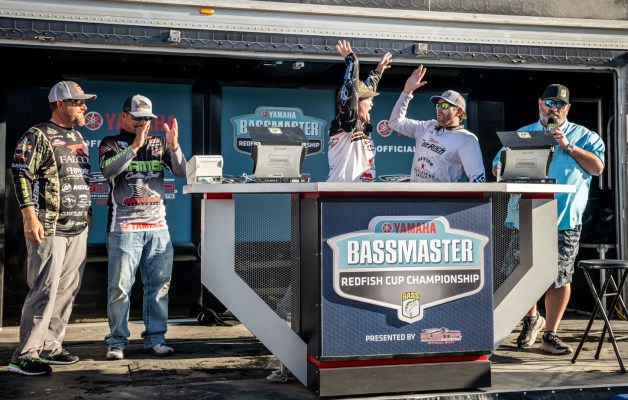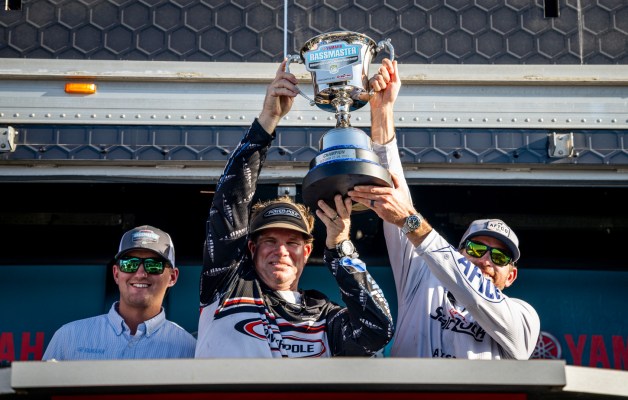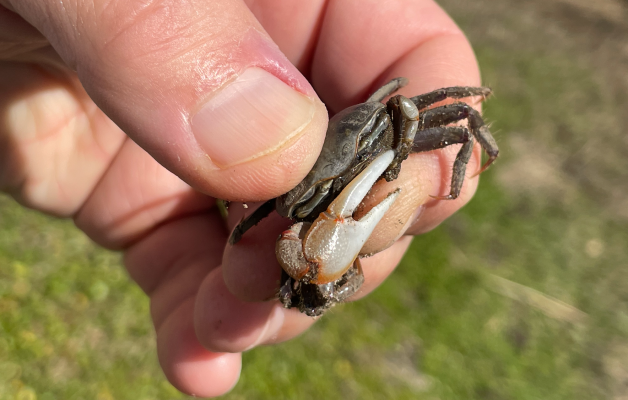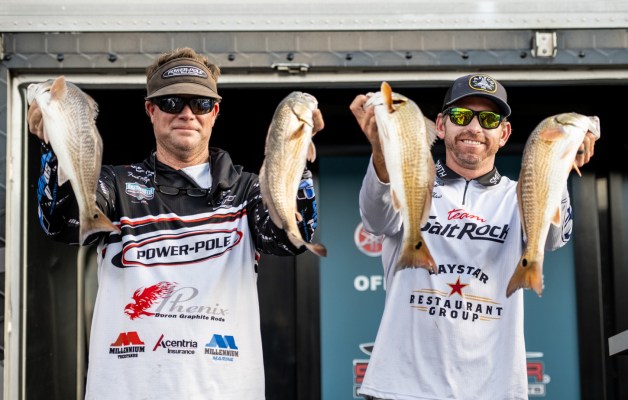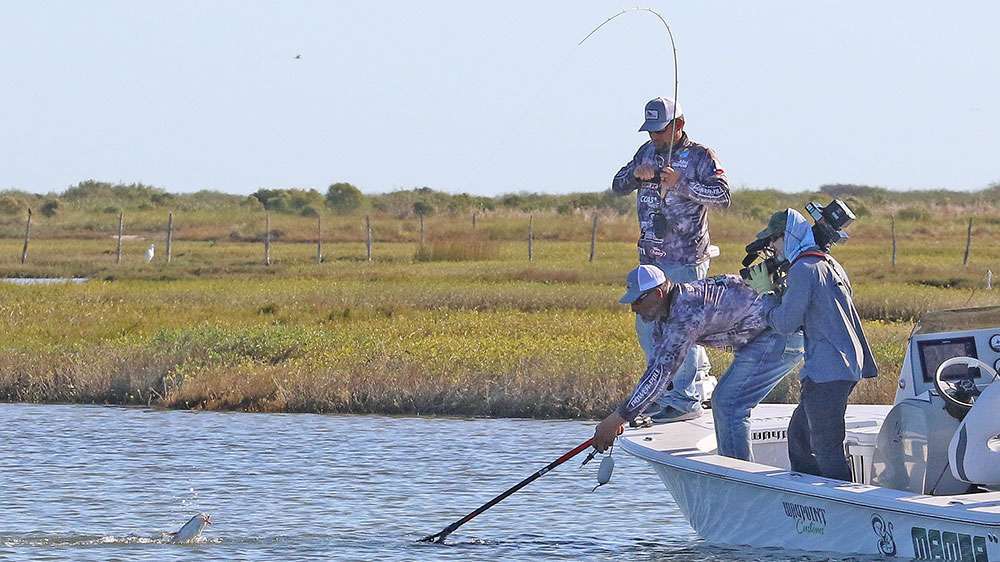
Since B.A.S.S. decided to pair six of the organization’s top anglers with established redfish pros for the Yamaha Bassmaster Redfish Cup Championship presented by Skeeter, the “crossover” concept has been thoroughly discussed. With Port Aransas living up to its nickname “Fishing Capital of Texas,” the event provided ample opportunity for the B.A.S.S. world to sample the vibrant coastal fishing realm, note the differences and see the similarities.
While the competition was well covered — in particular, three of the top-four teams included Bassmaster Elites — a handful of takeaways helped define this event. Of all the relevant angles, we find the simplest route to common ground in the truth that all competitive anglers practice for tournaments.
While the saltwater world occasionally calls it “prefishing,” the terms are interchangeable. That said, talks with a few of the competitors yielded some interesting compare/contrast observations.
Area: Tournament winners, IFA Redfish Tour angler Ryan Rickard and Elite angler Chris Zaldain knew that the event’s vast boundaries would require them to take the same measured approach Zaldain uses for sizable Elite venues.
“Compared to a normal Elite event, here in Port Aransas, we have a (nearly) 90-mile playing field, which isn’t different from, say, the St. Lawrence River, Toledo Bend, Santee Cooper — any of those big fisheries. Ryan and I broke it down to a north, central and south section.
“Much like on the Elite series, we took it by section over three days of practice and tried to refine a pattern. That is what surprised me the most about tournament redfishing — they are absolutely pattern-able, just like largemouth bass.”
Trying multiple lures across multiple depth zones, Zaldain and Rickard noted productivity and mentally filed plans for tournament days. Essential, Zaldain said, was finding multiple examples of productive scenarios.
“An area had to have three or four different ingredients and that is no different from smallmouth fishing the flats up north or flipping for largemouth down in Florida,” he said. “Ryan kept assuring me that, once you find redfish in the 26- to 28-inch range, you can count on this type of area to produce over the next three to four days, just like bass fishing.”
Look ahead: IFA Redfish Tour pro Ron Hueston said he and his Bassmaster Elite partner, Derek Hudnall, agreed that their first consideration should address meteorological conditions. Days 1 and 3 would turn out pleasant, but the forecast accurately predicted a second-round blow that would stir exposed areas, while placing a premium on leeward shores.
“Our first day of prefishing was based on knowing there was a front coming and there would be some nasty winds (on Day 2), so we prefished based on the weather that was coming,” Hueston said.
Conversely, Rickard and Zaldain selected a large grass flat at the upper end of Laguna Madre and committed to working their plan of targeting sand holes regardless of what the weather brought.
For many, the wind played a key role in propelling silent drifts across shallow areas, not unlike the wind drifts common to smallmouth anglers targeting rock reefs, shoals and dropoffs in the St. Lawrence River/Lake Ontario fishery.
While too much wind can push a boat too fast to accurately drop on smallies, the big Day 2 winds actually helped teams like Bassmaster Elite Patrick Walters and former FLW Redfish Championship winner Dwayne Eschete, who found they were able to make quicker, more efficient drifts to cover more of their flat.
Fish movement: Prior to moving to Fort Worth, Texas, Zaldain grew up on the California Delta, so he’s well-versed at tidal fishing. He found the local tides relatively light, but his background gave him the foundational understanding to work with his partner’s strategy.
“On the Delta, we have a 3 1/2-foot tide swing; here, it’s only about 9 inches to maybe a foot and a half on a big swing,” Zaldain said. “It’s a very short, subtle swing, but like every tidal bass fishery we fish, those bite windows absolutely depend on what that tide is doing.
“Ryan and I established a peak feeding time during that tide, so we could be in our best area where I caught a perfect tournament fish, just under 28 inches, during that ideal tide window.”
When, where and why: Hueston, who guides inshore charters in Southwest Florida, maintains his connection with the redfish scene, but recent years have found him expanding into local bass events. Given his dual perspective, he finds the redfish game a little more straightforward.
“For me, bass and redfish (strategy) is based on covering water and working a certain pattern, once I figure it out,” Hueston said. “I think you have to put more into bass in terms of developing a pattern because they seem to respond to many more factors than redfish do.”
As Hueston notes, weather and seasons can significantly alter bass positioning, while redfish generally hold to the same areas (prior to their offshore transition as adults). This, he said, can present bass anglers with a larger potential playing field, relevant to a particular fishery.
“With tides, a redfish can only go out so far and go in so far,” Hueston said. “But with bass, they tend to move around in all types of locations.”
Target package: Savvy bass anglers rarely pigeonhole themselves into an all-or-nothing deal. Rather, they’d like to flip matted grass while looking for holes and thin spots favoring a frog; or maybe a cove with docks, seawalls and rock, but also scattered brush piles. Same in the redfish game.
“A lot of the areas that we chose had options,” Zaldain said. “They have the deep water near by, they have the ultra-shallow flats, they have a couple hard bottom areas (oysters and shells) and they have sand bottom. We tried to stay in areas where we have options.”
Weapons free: While bass anglers typically shake off practice fish or use hookless baits, Zaldain said he was pleasantly surprised to find his partner actually preferred to stick what bit and thereby advance his game planning by getting a good look at what lived in their area.
As Zaldain pointed out, sore-lipping a big practice bass generally guarantees a week of pouting and minimal chance of that fish cooperating during the tournament. Rickard assured Zaldain that the feeding competition driving redfish schools leaves little room for self pity, so the ones they met in practice would likely have recomposed themselves in time for competition days.
Bass baits deliver
While most hybrid teams agreed that the redfish pro would initially select baits, bass anglers successfully employed traditional freshwater offerings. The most notable examples were:
Flipping baits: Day 1 saw Elite veteran Mark Menendez and multi-species pro Ricky Bort lead the field with two fish that bit a rig Mendez commonly uses in bass events: a black neon Strike King Rage Craw Texas rigged on a 5/0 Gamakatsu straight shank hook with a 3/16-ounce Strike King Tour Grade Tungsten weight.
Bladed jig: Day 2 saw Hudnall and Trait Zaldain pulling out the Z-Man ChatterBait JackHammer when a hard north wind stirred the waters. Both scored big bites that day and the next.
Swimbait: With lots of mullet traversing the flat he and Rickard were fishing, Zaldain abandoned the paddle tails and spoons he had been throwing in favor of a 6-inch Megabass Magdraft in the white back shad color. With redfish actively preying on mullet, this bait profile produced several big fish.
Safe to say, the bass pros picked up a few tips on redfish bait selection, but you know you’ve seen something truly unique when Bassmaster LIVE host Capt. Rick Murphy — the Florida pro with three decades of redfish experience — calls it a first for him.
Elite Redfish Tour anglers Glenn Vann and Thomas Barlow hung 1/2-ounce Bill Lewis Saltwater Rat-L-Traps under inverted popping corks. Traditionally, the wider end faces upward for maximum chugging commotion, but Vann and Barlow faced their narrow ends up for minimal disturbance.
Powerhouse
Consistent across the field of bass pros was one resonating impression: Redfish live in beast mode 24/7. Seasoned toad slingers well familiar with bucket-mouth studs complained of arm strain while trying to put the brakes on copper warriors that routinely stretched their string for much longer than the average bass fight — even the giants.
For comparison, we asked Menendez this question: If you tied a 5-pound black bass tail-to-tail with a 5-pound redfish, how long would it take the latter to drag the former across a football field of water?
“About 2.5 seconds,” Menendez laughed. “Unless it’s a Coosa River spotted bass — then it would take 4.5 seconds.”
Kindred spirits
Considering how bass pros compete individually, pundits pondered how the hybrid teams would mesh. Recalling that he and Bort had fished an event in the 1990s, Menendez said this event felt like “coming home.”
With everyone shaking hands for the first time in Port A, friendship and professional respect flowed like a spring tide. Most compelling was the ease with which these teams integrated their knowledge and opinions, while respecting one another’s contributions.
Many anglers said the right things on stage — no doubt, sincerely. However, when live TV coverage hears a gritty, no-nonsense redfish tournament veteran like Hueston spontaneously turn to his fellow competitor toward the end of Day 3 and say: “I’d partner with you any day,” you know the bonding is real.
“I could not have asked to be paired with a better partner,” Rickard said of his new-found friendship with Zaldain. “There’s so much to be said for the camaraderie on the boat; for gelling on the boat. Literally, from the first phone call with Chris, I knew it was the right fit. He thinks so similarly to me.
“I went into this event thinking ‘I don’t want to step on his toes. I’m not a pro; this guy’s a pro. So I didn’t want to be the guy telling him what to do. But he really took a back seat and said, ‘Hey bro, you tell us what to do and where to go.’”
Eschete and Walters, probably the most animated team, clearly meshed from square one. Working hard on the water and enjoying seafood dinners and ice cream after practice, they exemplified the multispecies bridging this event was designed to showcase.
As Eschete noted, Walters created a highlight reel moment on Day 2 en route to spotlighting one of the biggest differences between bass and redfish events.
“This is the only time in Patrick’s career that he’s caught a fish that was too big,” Eschete said of Walter’s 10-pound redfish that eclipsed the 28-inch maximum by 1/4-inch.
Menendez said this tournament proved not only enjoyable and enlightening but also motivational.
“We had a great time; this was a great opportunity to get out here and do something different,” he said. “On the Elite Series, you’re always on the run, you’re always on the grind, it’s the same old thing, the same old thing. This is going to breathe some life back into my fishing.”


